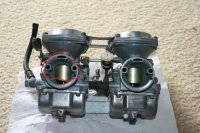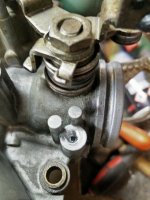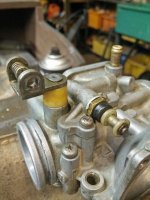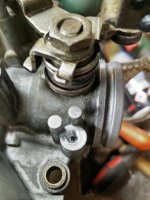pollestevens
XS enthousiast
A few months ago I purchased a 1977 Yamaha xs360. The bike was in a very rough condition when I bought it so i spent these last months rebuilding nearly everything.
I'm running stock-ish (not open) exhausts and the original carbs with pod filters. I replaced the #130 main jet with a #135 to compensate for the extra air. The pilot jet is the stock #17.5 ( pilot jets for xs360 carbs are very difficult to find so I couldn't bump up those) and the air/fuel screw is 2.5 turns out. Sparkplugs look good, maybe a little on the black side.
It starts up great and idles very good when the engine is cold but when it warms up it doesn't properly return to idle. It doesn't run bad when i'm accelerating but when i slow down the rpms drop very slowly.
These are the steps I took to troubleshoot the problem:
- New intake boots, gaskets, throttleshaft seals and diaphragms
There are no indications of false air when tested with carb clean. Slide seems to move properly
- Checked the valves
All clearenses were in to spec
- Checked the ingition timing and points gap
Timing was way off (points closed too late), reset the timing but made no difference.
- Carbs are synched
I also tried with velocity stacks because i read somewhere these CV carbs love 'em. It seems to be a little better but still not ideal.
This is as far as my knowledge about diagnosing idle issues reaches, did I miss anything that could cause these issues?
This is a picture of the (almost) finished bike

I'm running stock-ish (not open) exhausts and the original carbs with pod filters. I replaced the #130 main jet with a #135 to compensate for the extra air. The pilot jet is the stock #17.5 ( pilot jets for xs360 carbs are very difficult to find so I couldn't bump up those) and the air/fuel screw is 2.5 turns out. Sparkplugs look good, maybe a little on the black side.
It starts up great and idles very good when the engine is cold but when it warms up it doesn't properly return to idle. It doesn't run bad when i'm accelerating but when i slow down the rpms drop very slowly.
These are the steps I took to troubleshoot the problem:
- New intake boots, gaskets, throttleshaft seals and diaphragms
There are no indications of false air when tested with carb clean. Slide seems to move properly
- Checked the valves
All clearenses were in to spec
- Checked the ingition timing and points gap
Timing was way off (points closed too late), reset the timing but made no difference.
- Carbs are synched
I also tried with velocity stacks because i read somewhere these CV carbs love 'em. It seems to be a little better but still not ideal.
This is as far as my knowledge about diagnosing idle issues reaches, did I miss anything that could cause these issues?
This is a picture of the (almost) finished bike




